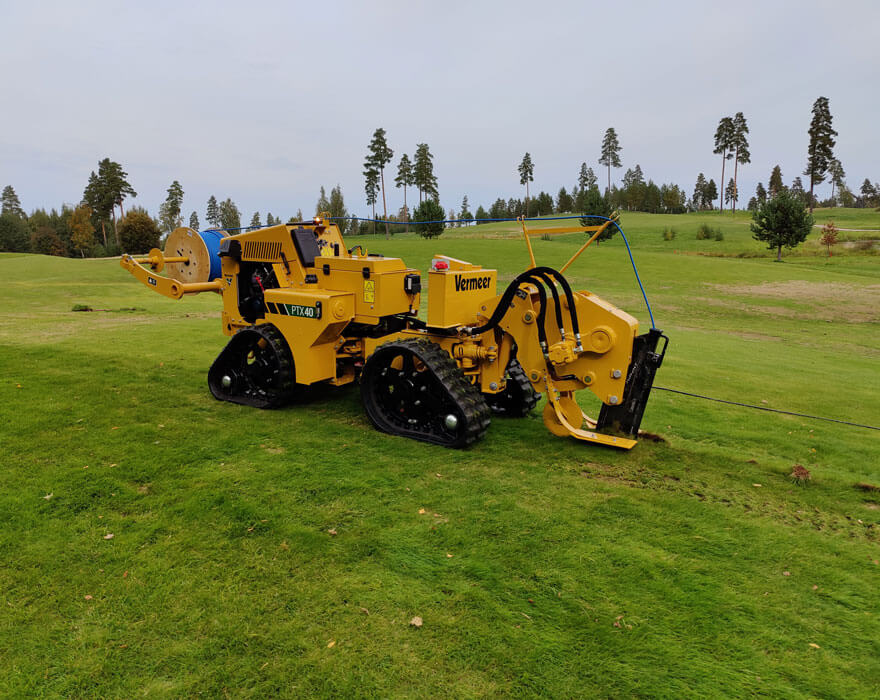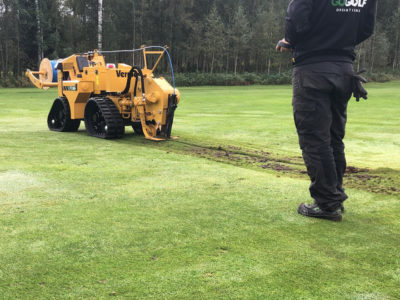Irrigation is vital to the health of a golf course because vigorous grass growth depends on ample and consistent watering. Beneath an expanse of short grass, two critical networks are concealed: one of water pipes and one of electricity to supply the sprinklers.
No one understands the challenges of maintaining these underground golf course irrigation networks better than Mikael Hästbacka, senior vice president of GoGolf in Espoo, Finland. He oversees day-to-day activities and ground maintenance.
“Many of Finland’s golf courses were designed and built in the ‘90s,” said Hästbacka. “Their irrigation systems are 25, even 30 years old, and showing their age.” GoGolf owns five courses and has a stake in another dozen. Quite a few of their irrigation networks need maintenance, replacement or extension.
“Another problem is lightning damage — thunderstorms are fairly common in spring and autumn,” explained Hästbacka. “A strike can cause damage that needs fixing promptly if the course isn’t to deteriorate. All in all, it translates to a pretty consistent workload keeping the irrigation systems in good shape.”
Plowing minimizes disturbance
Almost every building and outdoor facility is currently served by HDPE water pipes and power cables. Maintaining and upgrading such infrastructure represents a special challenge where a golf course is concerned. “To golfers a course is almost sacred, especially the greens,” Hästbackacontinued. “Groundworks can cause irreparable damage. You don’t want to dig trenches if you can possibly avoid it.”
“If you were replacing a water pipe outside a house or an office building, you might use a chain trencher to cut a slit trench,” said Hästbacka. “But that requires very precise backfilling of the trench. Even then, trenching always leaves surface irregularities. Not to mention the time it takes for new grass to grow or new turf to root.”
For GoGolf, plowing provides a solution for golf course irrigation installation. The company’s Vermeer PTX40 plow/trencher is designed specifically for installing fiberoptic, electrical, gas and irrigation services. Although the versatile machine can also create trenches more than a meter (3 ft) deep and 15 cm (5.9 in) wide, its plow functionality is what makes it valuable to GoGolf. No bigger than a professional ride-on lawnmower, the walk-beside PTX40 is guided along the route of the pipe or cable to be laid. As it travels, an oscillating rear-mounted sod cutter makes a surgical incision in the ground.
“Only the turf and the first third to two-thirds of a meter (1 to 2 feet) of topsoil are cut, and no earth is removed,” said Hästbacka. “Everything happens as part of a single continuous process. A cut is made and gently pried open. Then the pipe is pulled in behind the plow blade, while the cable is simultaneously being fed through a chute and the cut is reclosed.” This all happens while the plow is moving. “All we do is drive the PTX40 back over the route, so that its four rubber mini tracks press the soil back down. After that, the cut is usually invisible.”
Damage is also kept to a minimum. “That makes a massive difference to the direct and indirect project costs,” said Hästbacka. “Because, when a course isn’t in use, you’re losing income. You’re missing out on green fees, but also on the income from clubhouse trade, competitions and so on.”
As well as avoiding settlement-related surface hollowing that open trenching brings, plowing can offer productivity benefits. “Using the PTX40 for pipe-laying is a big time-saver,” confirmed Hästbacka. “The plow moves along the route at a slow walking pace, meaning we can do the entire length of a fairway in a few hours. Excavating a trench of that length would take days.”

Maneuverability allows precise installation
Being center-articulated, the PTX40 is highly maneuverable. That’s another plus for GoGolf, because tight turns can be made, and cables can efficiently be routed around natural and man-made obstacles. Hästbacka also likes the remote-control capability. “Precision and quality are really important in the kind of maintenance work we do. And that depends on being able to see exactly what’s happening, so you can make adjustments as you go and respond immediately if you hit a snag. With the Vermeer plow, the operator stands at the side, with a hand-held control unit. Our guy can move around, get a look from different angles and intervene whenever there’s a need. “
While cables and irrigation pipes on golf courses often run in straight lines beneath open terrain, that isn’t always the case. “As you can see,” Hästbackasaid, “here at Annila we have stands of trees separating parallel fairways and little wooded hillocks that players have to navigate around. They make the course interesting to play, but they complicate the business of laying cables and pipes. Having a compact machine that can squeeze between trees — it’s only a meter (3 ft) or so wide — is a big help. And don’t make the mistake of thinking that because it’s small it doesn’t pack a punch. It’s got a Kubota gasoline engine that’s rated at about 35 kW (47 hp) — not far off a small hatchback! So, it’s got the traction to handle gradients and irregular surfaces.”
For a company with a large number of vehicles and a corporate philosophy built around efficiency, serviceability is another key consideration. “As well as the Vermeer machine, we have aerators and seed drills, multi-purpose tractor units and lots of mowers of all sizes and all makes,” acknowledged Hästbacka. “Managing the cost of a vehicle fleet like that is obviously critical. Major repairs and servicing are contracted out, but you can’t be calling in an engineer every time the oil needs topping up. Day-to-day maintenance is handled by our own ground staff. And the PTX40 is ideal from that viewpoint. The service points are easy to access, and you can check levels and filters without needing to remove any covers.”
This article contains third-party observations, advice or experiences that do not necessarily reflect the opinions of Vermeer Corporation, its affiliates or its dealers. Testimonials and/or endorsements by customers in specific circumstances may not be representative of normal circumstances experienced by all customers.
Vermeer Corporation reserves the right to make changes in engineering, design and specifications; add improvements; or discontinue manufacturing at any time without notice or obligation. Equipment shown is for illustrative purposes only and may display optional accessories or components specific to their global region. Please contact your local Vermeer dealer for more information on machine specifications.
Vermeer and the Vermeer logo are trademarks of Vermeer Manufacturing Company in the U.S. and/or other countries. Kubota is a trademark of Kubota Engine Co. © 2023 Vermeer Corporation. All Rights Reserved.
